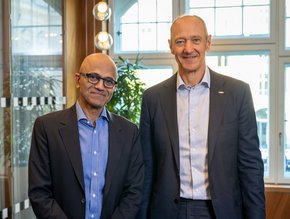Workplace (Facebook): how video is changing business culture

Business culture and working practices have evolved dramatically over the last few decades, changing in line with modern ideals and technology developments. In recent months, lockdown has sparked a rapid wave of change like no other, forcing businesses to adapt how - and from where - they operate in order to keep the lights on and ensure staff safety.
Technologies are known to influence the culture around us and, during lockdown, have defined how we interact and communicate with our personal and professional communities. Take corporate communication for example. Email is now a legacy communication tool. And while many businesses rely on it to communicate and get work done, it’s a fairly rigid way of working. With little innovation over the years, many organisations have outgrown the slow moving and formal process of emailing. For some, email has become the new answer machine of business communication where you’re just left waiting for a reply.
The corporate communication journey
As textspeak developed with SMS communication, email culture has created its own vernacular with employees promising to ‘circle back’, ‘loop in’ and ‘take it offline’. But it has always been supplemented by phone calls and, later on, access to instant messaging. These encourage more synchronous communication and the quick-fire questions that people need to get things done in real-time.
In recent times, Emojis and GIFs have arrived in the workplace. A big jump for businesses enabling employees to express feelings in shorthand while at work - opening the door for honest and constructive feedback, creativity and even humour.
Now -- with an increasingly remote workforce that looks like it is here to stay -- we are entering into the next stage of corporate language: video.
Creating virtual communities in lockdown
During the pandemic, video has been critical in keeping friends and families connected on a meaningful level that simply can’t be matched by the likes of email and text. In many of the places most impacted by the virus in March, voice and video calling more than doubled in Messenger and WhatsApp, and Facebook Live views doubled in just one week in Italy.
In the world of work, video has helped to keep employees connected with each other in recent months regardless of their situations - whether they’ve been at home with family, working on the frontline or even temporarily not able to work at all. Many of our customers such as UK restaurant company Bistrot Pierre found that using Live video on Workplace over the lockdown helped them keep in touch with staff and get everyone together for social activities. Using the power of video in conjunction with clear communication, firms have been able to scale their company culture virtually and build a true digital community.
Video is also a hugely engaging and inclusive way of working since it echoes face-to-face conversation and bridges physical distance. With video posts and calls, employees can see and interact with colleagues, ask questions in real-time and participate in conversations wherever they are. This helps employees to remain close to their teams, to the decisions businesses are making and to senior leaders, which can often be a sticking point for engagement.
One thing we’ve learnt is that speed, inclusion and engagement are critical during a pandemic. Organisations need to be able to send critical health and safety updates quickly and holistically to distributed workforces - and rely on the fact that employees will receive those updates. In response to this, we’ve seen more and more leaders turning to live video broadcasts. Enabling mission critical updates to reach every employee in real time, live video is also helping to create a new style of leadership - one defined by transparency and authenticity. And in times of uncertainty this can help build trust within the workforce and enable real-time staff feedback.
Video and the future world of work
Looking ahead, a full return to the office won’t happen overnight. Offices will have reduced capacity and many employees simply won’t be able to rush back because of personal circumstances, from caring or home-schooling responsibilities to health reasons. At the same time, there will continue to be essential customer facing and frontline workers as shops restaurants and transport reopens. Businesses will be operating in more of a hybrid environment than ever - with employees distributed across the frontline, the office and home.
As a result, organisations will need to look to find the sweet spot where they can offer employees a space to ‘meet in the middle’ virtually. Video will continue to play a big role in creating this space, keeping colleagues connected and developing community feel. And when combined with continued flexibility, these remote working muscles formed over the last few months will help companies to attract remote staff that were previously inaccessible for location or situational reasons. Beyond attracting new people, businesses who invest in their online culture will be able to retain them too - since employees come for the company but stay for the community.
Video has been crucial for businesses, communities and individuals across the world to stay connected during lockdown. And as video tools continue to get better thanks to new technologies like AR and AI, it will only become a more powerful tool in business. Having already helped organisations reduce physical distance, new innovations will continue to break down barriers - whether that’s in language, accessibility or flexible hours - in the workplace.
For more information on business topics in Europe, Middle East and Africa please take a look at the latest edition of Business Chief EMEA.






